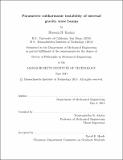Parametric subharmonic instability of internal gravity wave beams
Author(s)
Karimi, Hussain H. (Hussain Habibullah)
DownloadFull printable version (15.87Mb)
Other Contributors
Massachusetts Institute of Technology. Department of Mechanical Engineering.
Advisor
Triantaphyllos R. Akylas.
Terms of use
Metadata
Show full item recordAbstract
Internal gravity wave beams are time-harmonic plane waves with general spatial pro- le that arise in continuously stratified fluids owing to the anisotropy of this wave motion. In the last decade, these wave disturbances have been at the forefront of research, both from a fundamental perspective and in connection with various geophysical ow processes. Oceanic internal wave beams, in particular, form the backbone of the internal tide, generated by the interaction of the barotropic tide with sea-floor topography. The internal tide breakdown and its role in deep-ocean mixing have attracted considerable attention. In this context, it is of interest to understand mechanisms by which internal wave beams become unstable and eventually breakdown, thereby contributing to mixing. A possible instability mechanism is via resonant triad interactions that amplify short-scale perturbations with frequency equal to one half of that of the underlying wave. For spatially and temporally monochromatic internal waves, this so-called parametric subharmonic instability (PSI) has been studied extensively and indeed can lead to breakdown. By contrast, the focus here is on understanding how wave beams with locally conned spatial prole, such as those in the field, may differ, in regard to PSI, from monochromatic plane waves. To this end, an asymptotic analysis is made of the interaction of a small-amplitude wave beam with short-scale subharmonic wavepackets in a nearly inviscid stratified Boussinesq uid. A novel system of coupled evolution equations that govern this nonlinear interaction is derived and analyzed. For beams with general localized prole, unlike monochromatic wavetrains, it is found that triad interactions are not strong enough to bring about instability in the limited time that subharmonic perturbations overlap with the beam. On the other hand, for quasi-monochromatic wave beams whose prole comprises a sinusoidal carrier modulated by a locally conned envelope, PSI is possible if the beam is wide enough. In this instance, a stability criterion is proposed which, under given ow conditions, provides the minimum number of carrier wavelengths a beam of small amplitude must comprise for instability to arise. Furthermore, the eect of the Earth's rotation on PSI of internal wave beams is investigated. Even though rotation induces transverse motion, plane waves in the form of beams are still possible. Most importantly, however, in the presence of rotation, short-scale subharmonic wavepackets may experience prolonged interaction with a beam of general localized prole, potentially causing instability. This situation arises when the subharmonic frequency nearly matches the background Coriolis frequency so the group velocity of subharmonic wavepackets is close to zero. In particular, wave beams generated by the M₂ tidal ow over topography encounter this resonance near the critical latitude of 28.8° (N and S). Coupled evolution equations for subharmonic wavepackets riding on a beam of general prole under such resonance conditions are derived. Based on this asymptotic model, it is shown that locally conned beams above a certain threshold amplitude are unstable to near-inertial subharmonic disturbances. The theoretical predictions are supported by recent field observations which show that signicant energy transfer to subharmonic disturbances does indeed occur near the critical latitude and not elsewhere.
Description
Thesis: Ph. D., Massachusetts Institute of Technology, Department of Mechanical Engineering, 2015. This electronic version was submitted by the student author. The certified thesis is available in the Institute Archives and Special Collections. Cataloged from student-submitted PDF version of thesis. Includes bibliographical references (pages 113-117).
Date issued
2015Department
Massachusetts Institute of Technology. Department of Mechanical EngineeringPublisher
Massachusetts Institute of Technology
Keywords
Mechanical Engineering.